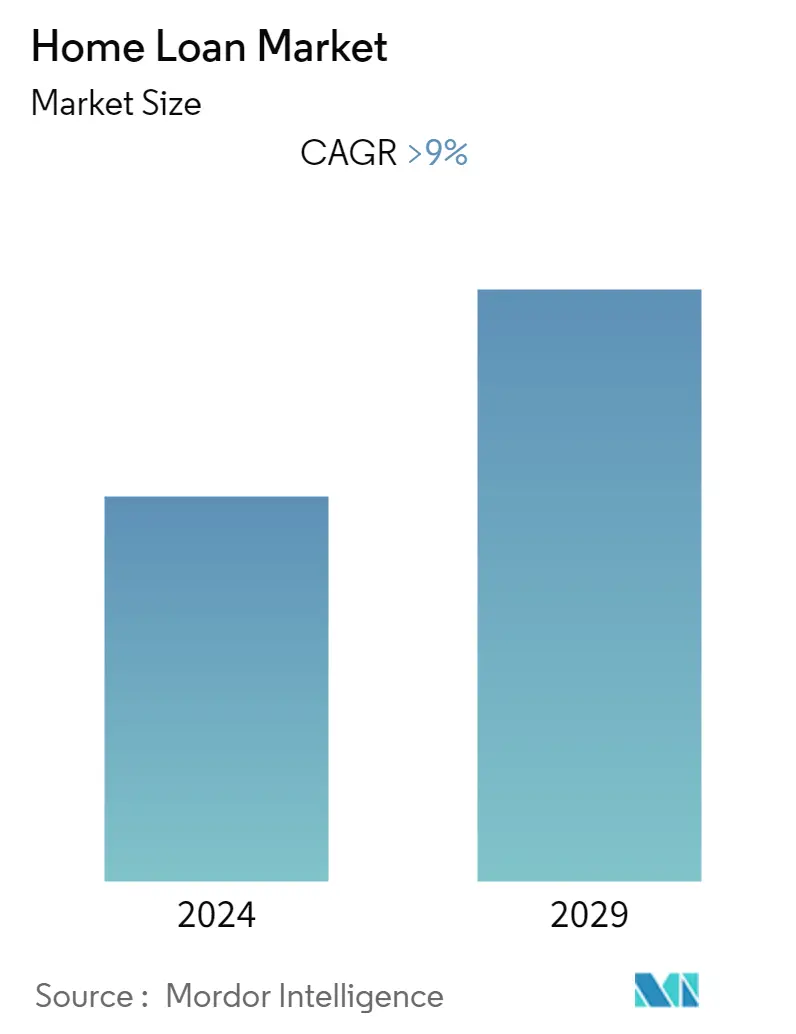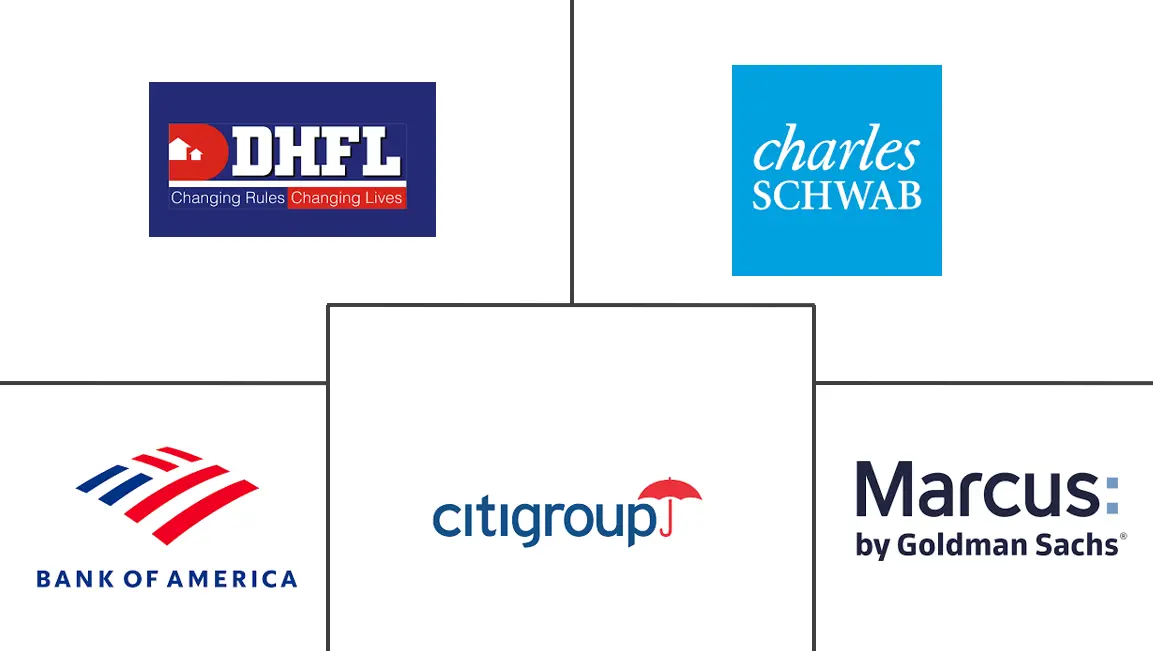Market Size of Home Loan Industry

| Study Period | 2020 - 2029 |
| Base Year For Estimation | 2023 |
| Forecast Data Period | 2024 - 2029 |
| Historical Data Period | 2020 - 2022 |
| CAGR | 9.00 % |
| Market Concentration | Medium |
Major Players
*Disclaimer: Major Players sorted in no particular order |
Home Loan Market Analysis
Home Loan Market has generated a revenue of USD 13000 billion in the current year and is poised to achieve a CAGR of 9% for the forecast period. The home loan market varies across regions due to differences in economic conditions, regulatory frameworks, cultural factors, and housing market dynamics. Developed countries often have well-established home loan markets with extensive banking systems, while emerging economies may have less developed mortgage markets. Commercial banks, including global banking institutions, play a significant role in the home loan market. They offer a range of mortgage products and services to borrowers.
Non-banking financial institutions and specialized mortgage lenders also participate in the home loan market. These lenders often focus solely on mortgage lending and may offer more specialized loan products. In many countries, government-sponsored enterprises or agencies facilitate home loan financing. Examples include Fannie Mae and Freddie Mac in the United States.
With the rise of financial technology, online lenders have emerged as alternative sources of home loans. These digital platforms provide convenient and often streamlined application processes. Changes in interest rates significantly impact the home loan market. Lower interest rates tend to stimulate borrowing activity, while higher rates can discourage borrowing. Economic factors such as employment rates, inflation, and GDP growth affect the overall demand for home loans. A robust economy with stable employment often increases demand for housing and home loans.
Government policies and regulations related to the housing market, mortgage lending, and interest rates can significantly impact the global home loan market. Policies aimed at promoting homeownership or regulating lending practices can influence market dynamics. The state of the real estate market, including property prices and housing supply, plays a crucial role in the home loan market. Market conditions can affect affordability and borrower demand.
The COVID-19 pandemic created substantial market volatility and uncertainty. Housing markets experienced fluctuations, with varying impacts depending on local conditions. Some regions witnessed a slowdown in home sales and construction activity, while others experienced increased demand for housing due to changing work-from-home dynamics.
Home Loan Industry Segmentation
The global home loan market refers to the financial market where individuals and families borrow money from financial institutions to purchase or refinance residential properties. Home loans, also known as mortgages, are long-term loans typically repaid over several years or decades. Home Loan Market is Segmented By Purpose (Home Purchase, Refinance, Home Improvement, Construction, Other), By End User (Employed Individuals, Professionals, Students, Entrepreneur, Others (Homemakers, Unemployed, Retired, etc.)), By Tenure (Less Than 5 years, 6-10 years, 11-24 years, and 25-30 years), By Geography (North America, Europe, Asia-Pacific, Middle-East and Africa, South America). The report offers market size and forecasts for the Home Loan Market in value (USD Billion) for all the above segments.
| By Purpose | |
| Home Purchase | |
| Refinance | |
| Home Improvement | |
| Construction | |
| Other |
| By End User | |
| Employed Individuals | |
| Professionals | |
| Students | |
| Entrepreneur | |
| Others (Homemaker, Unemployed, Retired, etc.) |
| By Tenure | |
| Less Than 5 years | |
| 6-10 years | |
| 11-24 years | |
| 25-30 years |
| By Geography | |||||||||
| |||||||||
| |||||||||
| |||||||||
| |||||||||
|
Home Loan Market Size Summary
The home loan market is a dynamic and evolving sector influenced by a variety of factors including economic conditions, regulatory frameworks, and cultural nuances. In developed countries, the market is characterized by well-established banking systems and a wide array of mortgage products offered by commercial banks and global financial institutions. In contrast, emerging economies often have less developed mortgage markets, with state-owned banks playing a significant role. The rise of financial technology has introduced online lenders as alternative sources, providing convenient and streamlined application processes. Economic indicators such as interest rates, employment rates, inflation, and GDP growth are crucial in shaping the demand for home loans, with lower interest rates typically stimulating borrowing activity.
The competitive landscape of the global home loan market is marked by numerous players striving for market share through competitive interest rates, flexible terms, and personalized customer experiences. Government policies and regulations significantly impact market dynamics, influencing homeownership promotion, lending practices, and housing supply. The COVID-19 pandemic introduced volatility, affecting housing demand and construction activity variably across regions. Rapid urbanization and limited land availability have driven up housing demand and prices, particularly in desirable locations. The market is dominated by major companies such as Bank of America, Citigroup, and JPMorgan Chase, which continuously innovate to meet changing consumer needs and regulatory requirements.
Home Loan Market Size - Table of Contents
-
1. MARKET DYNAMICS AND INSIGHTS
-
1.1 Market Overview
-
1.2 Market Drivers
-
1.2.1 Real Estate Market Trends
-
1.2.2 Government Policies
-
-
1.3 Market Restraints
-
1.3.1 Interest rates on Home Loans
-
1.3.2 Market Volatility and Uncertainty
-
-
1.4 Insights on Various Regulatory Trends Shaping the Market
-
1.5 Insights on impact of technology in the Market
-
1.6 Industry Attractiveness - Porters' Five Forces Analysis
-
1.6.1 Threat of New Entrants
-
1.6.2 Bargaining Power of Buyers
-
1.6.3 Bargaining Power of Suppliers
-
1.6.4 Threat of Substitutes
-
1.6.5 Intensity of Competitive Rivalry
-
-
1.7 Impact of COVID-19 on the Market
-
-
2. MARKET SEGMENTATION
-
2.1 By Purpose
-
2.1.1 Home Purchase
-
2.1.2 Refinance
-
2.1.3 Home Improvement
-
2.1.4 Construction
-
2.1.5 Other
-
-
2.2 By End User
-
2.2.1 Employed Individuals
-
2.2.2 Professionals
-
2.2.3 Students
-
2.2.4 Entrepreneur
-
2.2.5 Others (Homemaker, Unemployed, Retired, etc.)
-
-
2.3 By Tenure
-
2.3.1 Less Than 5 years
-
2.3.2 6-10 years
-
2.3.3 11-24 years
-
2.3.4 25-30 years
-
-
2.4 By Geography
-
2.4.1 North America
-
2.4.1.1 United States
-
2.4.1.2 Canada
-
2.4.1.3 Rest of North America
-
-
2.4.2 South America
-
2.4.2.1 Brazil
-
2.4.2.2 Argentina
-
2.4.2.3 Colombia
-
2.4.2.4 Chile
-
2.4.2.5 Rest of South America
-
-
2.4.3 Europe
-
2.4.3.1 UK
-
2.4.3.2 Germany
-
2.4.3.3 France
-
2.4.3.4 Italy
-
2.4.3.5 Netherlands
-
2.4.3.6 Rest of Europe
-
-
2.4.4 Asia-Pacific
-
2.4.4.1 China
-
2.4.4.2 Japan
-
2.4.4.3 India
-
2.4.4.4 Australia
-
2.4.4.5 Singapore
-
2.4.4.6 South Korea
-
2.4.4.7 Rest of Asia-Pacific
-
-
2.4.5 Middle East & Africa
-
2.4.5.1 Saudi Arabia
-
2.4.5.2 Egypt
-
2.4.5.3 UAE
-
2.4.5.4 Rest of Middle East and Africa
-
-
-
Home Loan Market Size FAQs
What is the current Home Loan Market size?
The Home Loan Market is projected to register a CAGR of greater than 9% during the forecast period (2024-2029)
Who are the key players in Home Loan Market?
Bank of America Corporation, Charles Schwab & Co., Citigroup, Inc., Dewan Housing Finance Corporation Limited and Goldman Sachs (Marcus) are the major companies operating in the Home Loan Market.

